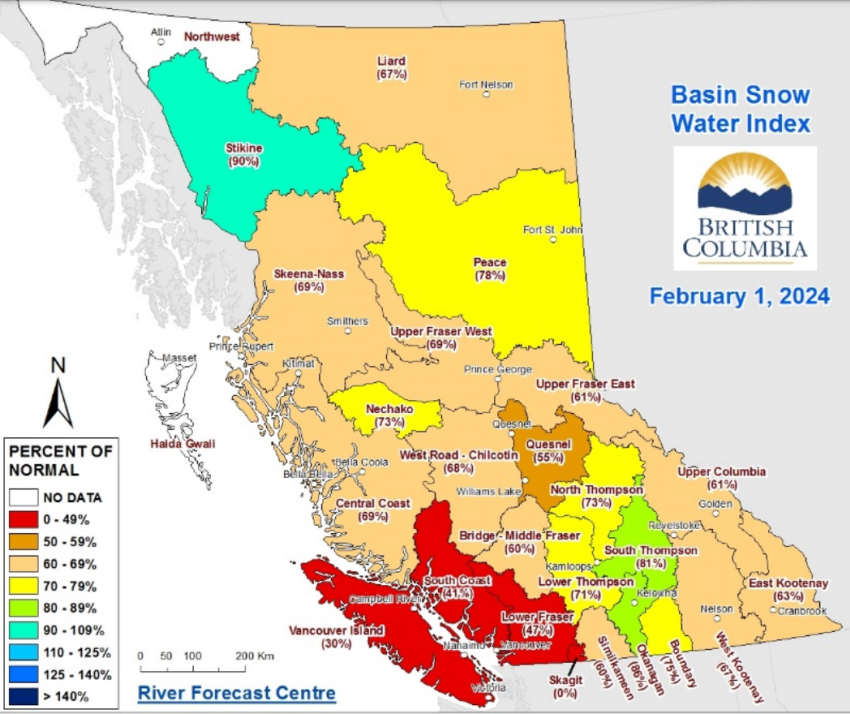The latest data on BC’s snowpack levels has sparked concern from several organizations about the impacts to water sources and fish populations.
The latest data has also prompted calls for provincial and federal leaders to step up their efforts to protect water security in BC.
On Thursday, the Ministry of Water, Land and Resource Stewardship released a report that shows provincial snowpack averages are “very low,” sitting at about 39% below normal levels for Feb. 1.
The snowpack levels were about 21% below normal levels this time last year.
“Low snowpack and seasonal runoff forecasts combined with warm seasonal weather forecasts and lingering impacts from previous drought are creating significantly elevated drought hazards for this upcoming spring and summer,” the province said.

In a release issued late Thursday evening, Living Lakes Canada says there is “significant” concern about the likelihood of experiencing another record drought this summer, marking about four years of ongoing drought.
The charitable water stewardship NGO explains that snowpacks serve as natural reservoirs, gradually releasing water during the spring snowmelt, which “recharge” rivers, streams, wetlands, lakes and groundwater.
When snowpack levels are as low as they are now, it poses a threat to the availability of freshwater, which they say is critical for agriculture, community water systems and ecosystem health.
In the Columbia Basin in southeastern BC, where Living Lakes Canada is based, snowpacks in the Upper Columbia, West Kootenay and East Kootenay regions are sitting at 30%, 33% and 37% below normal respectively.
“The low snowpack being recorded across the Columbia Basin has concerning implications for water supply throughout the rest of 2024,” said Paige Thurston, Columbia Basin Water Monitoring Framework Program Manager with Living Lakes Canada.
“Unless conditions shift in the next few months, communities should be prepared for low stream flows this summer.”
When severe droughts are combined with devastating wildfire seasons, like 2023, this can further lead to home losses, damaged municipal water supply structures, increased water restrictions, drops in aquifer levels, low flows in rivers and streams, and wetlands and lakes drying out, Living Lakes says.

The impacts of drought also extend to local ecosystems, including salmon populations, says the Watershed Watch Salmon Society (WWSS).
Last month, the WWSS called on the provincial and federal governments to put a plan in place when 15 snow stations set record lows on Jan. 1, including five in the Lower Fraser region and four in the Upper Columbia region.
According to the measurements for Feb. 1, nine snow stations measured all-time lows for their period of record, including basins in the Upper Fraser East, Quesnel/Middle Fraser, North Thompson and Upper Columbia.
Some of those basins saw the lowest levels of snow recorded in 55 to 60 years.
The WWSS points to the devastating impacts the 2023 drought had on farmers, communities and aquatic species across the province.
“The consequences were far-reaching, ranging from farmers running out of hay, thousands of dead salmon cooked to death in shallow waterways, businesses losing water access, and drinking water supply for First Nations and municipalities reaching dangerously low levels,” the society said in a statement.
In mid-August, when most of the province was under drought levels four or five, the government put fish protection orders in place for the Thompson Okanagan region, which temporarily restricted water use for forage crops for about 400 surface and groundwater licence holders.
Aaron Hill, executive director of the WWSS, said the province is going to need to see a lot more snow over the next few months to increase water supply enough to support salmon populations and avoid a repeat of last year.
Although some significant snow fell in the province in mid-January, the benefits were minimal due to above seasonal temperatures that returned at the end of the month and a drier than normal first week in February.
Hill and the WSS said the provincial and federal leaders needed to do more to ensure water security in the province.
“We need the provincial government to step up NOW with proactive drought planning. We can’t afford to repeat the previous pattern of doing nothing until the crisis is upon us,” Hill said.
Living Lakes Canada Executive Director Kat Hartwig says they continue to work with all levels of government to safeguard water and are also calling on the provincial government to create a Watershed Management System across the province and invest $75 million annually into BC’s Watershed Security Fund.
“As a member of the BC Watershed Security Coalition, Living Lakes Canada joins numerous other organizations across the province calling for strong, decisive action by the BC Government in response to severe drought conditions experienced in 2023 and beginning now for 2024,” said Hartwig.
“At this stage, it is essential to rapidly generate collaborative problem-solving approaches both provincially and at the local scale where the impacts occur,” Hartwig says.
Although there are still two three months left in the snow season, where conditions may change, the current trends of low snowpack are expected to continue, resulting in below normal spring freshet, especially in the Interior region.
















